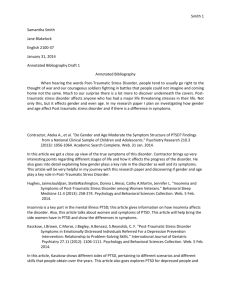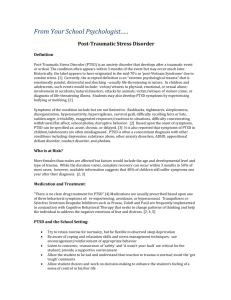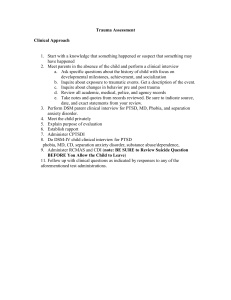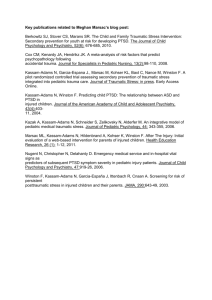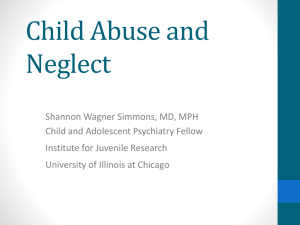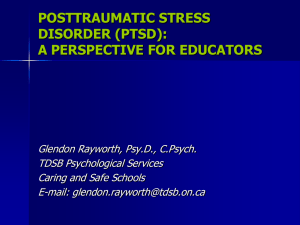Psychiatry Workgroup Minutes- Anxiety segment
advertisement
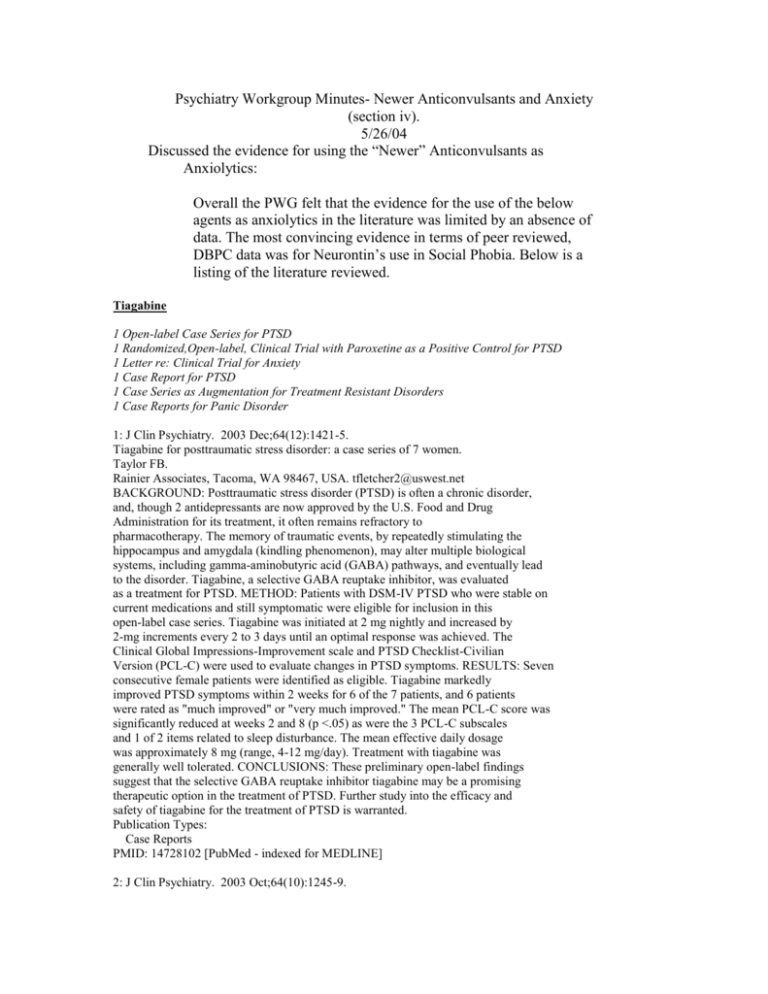
Psychiatry Workgroup Minutes- Newer Anticonvulsants and Anxiety (section iv). 5/26/04 Discussed the evidence for using the “Newer” Anticonvulsants as Anxiolytics: Overall the PWG felt that the evidence for the use of the below agents as anxiolytics in the literature was limited by an absence of data. The most convincing evidence in terms of peer reviewed, DBPC data was for Neurontin’s use in Social Phobia. Below is a listing of the literature reviewed. Tiagabine 1 Open-label Case Series for PTSD 1 Randomized,Open-label, Clinical Trial with Paroxetine as a Positive Control for PTSD 1 Letter re: Clinical Trial for Anxiety 1 Case Report for PTSD 1 Case Series as Augmentation for Treatment Resistant Disorders 1 Case Reports for Panic Disorder 1: J Clin Psychiatry. 2003 Dec;64(12):1421-5. Tiagabine for posttraumatic stress disorder: a case series of 7 women. Taylor FB. Rainier Associates, Tacoma, WA 98467, USA. tfletcher2@uswest.net BACKGROUND: Posttraumatic stress disorder (PTSD) is often a chronic disorder, and, though 2 antidepressants are now approved by the U.S. Food and Drug Administration for its treatment, it often remains refractory to pharmacotherapy. The memory of traumatic events, by repeatedly stimulating the hippocampus and amygdala (kindling phenomenon), may alter multiple biological systems, including gamma-aminobutyric acid (GABA) pathways, and eventually lead to the disorder. Tiagabine, a selective GABA reuptake inhibitor, was evaluated as a treatment for PTSD. METHOD: Patients with DSM-IV PTSD who were stable on current medications and still symptomatic were eligible for inclusion in this open-label case series. Tiagabine was initiated at 2 mg nightly and increased by 2-mg increments every 2 to 3 days until an optimal response was achieved. The Clinical Global Impressions-Improvement scale and PTSD Checklist-Civilian Version (PCL-C) were used to evaluate changes in PTSD symptoms. RESULTS: Seven consecutive female patients were identified as eligible. Tiagabine markedly improved PTSD symptoms within 2 weeks for 6 of the 7 patients, and 6 patients were rated as "much improved" or "very much improved." The mean PCL-C score was significantly reduced at weeks 2 and 8 (p <.05) as were the 3 PCL-C subscales and 1 of 2 items related to sleep disturbance. The mean effective daily dosage was approximately 8 mg (range, 4-12 mg/day). Treatment with tiagabine was generally well tolerated. CONCLUSIONS: These preliminary open-label findings suggest that the selective GABA reuptake inhibitor tiagabine may be a promising therapeutic option in the treatment of PTSD. Further study into the efficacy and safety of tiagabine for the treatment of PTSD is warranted. Publication Types: Case Reports PMID: 14728102 [PubMed - indexed for MEDLINE] 2: J Clin Psychiatry. 2003 Oct;64(10):1245-9. Tiagabine for the treatment of generalized anxiety disorder: a randomized, open-label, clinical trial with paroxetine as a positive control. Rosenthal M. BMR HealthQuest, 3625 Ruffin Road, Suite 100, San Diego, CA 92123, USA. rosenthal@bmrhealthquest.com BACKGROUND: Gamma-aminobutyric acid (GABA) plays a central role in the pathophysiology of anxiety. Tiagabine, a selective GABA reuptake inhibitor, enhances normal GABA tone. This 10-week, randomized, open-label trial evaluated tiagabine in patients with generalized anxiety disorder (GAD), with paroxetine serving as a positive control. METHOD: Adult patients with DSM-IV GAD were randomly assigned to receive either tiagabine or paroxetine. Tiagabine was initiated at 4 mg/day (2 mg morning and evening) during week 1. Between weeks 2 and 6, the dose was individually titrated in 2-mg increments (maximum increase of 4 mg/week) for optimal response to a maximum dose of 16 mg/day (8 mg morning and evening). During weeks 7 through 10, patients received the dosage determined during the titration period. Paroxetine was initiated at 20 mg nightly for the first week and similarly titrated in 10-mg increments to a maximum dose of 60 mg/day. Assessments included the Hamilton Rating Scale for Anxiety (HAM-A), Hospital Anxiety and Depression Scale (HADS), Hamilton Rating Scale for Depression (HAM-D), Pittsburgh Sleep Quality Index (PSQI), and Sheehan Disability Scale (SDS). RESULTS: Forty patients were enrolled (tiagabine, N = 20; paroxetine, N = 20). Mean final doses were tiagabine 10 mg/day (range, 4-16 mg/day) or paroxetine 27 mg/day (range, 20-40 mg/day). Tiagabine and paroxetine significantly reduced anxiety (HAM-A and HADS total and anxiety subscales). Although patients were not diagnosed with a mood disorder, both tiagabine and paroxetine reduced comorbid depressive symptoms (HAM-D total and HADS total and depressive subscale). Tiagabine and paroxetine significantly improved sleep quality (PSQI) and functioning (SDS). Both tiagabine and paroxetine were well tolerated. CONCLUSION: The selective GABA reuptake inhibitor tiagabine and the positive control paroxetine significantly reduced anxiety and comorbid depressive symptoms, improved sleep quality and functioning, and were well tolerated in patients with GAD. Tiagabine may be a therapeutic option for the treatment of anxiety disorders. Publication Types: Clinical Trial Randomized Controlled Trial PMID: 14658975 [PubMed - indexed for MEDLINE] 3: Depress Anxiety. 2003;18(1):51-2. Tiagabine for the treatment of anxiety. Crane D. Publication Types: Clinical Trial Letter PMID: 12900953 [PubMed - indexed for MEDLINE] 4. Can J Psychiatry. 2002 Oct;47(8):788. Treatment of posttraumatic stress disorder with tiagabine. Berigan T. Publication Types: Case Reports Letter PMID: 12420661 [PubMed - indexed for MEDLINE] 5. Psychopharmacol Bull. 2002 Spring;36(2):53-7. The use of tiagabine augmentation for treatment-resistant anxiety disorders: a case series. Schwartz TL. Department of Psychiatry, SUNY Upstate Medical University, 750 East Adams Street, Syracuse, NY 13210, USA. thomas_Schwartz@yahoo.com Tiagabine is currently approved by the Food and Drug Administration for use in treating certain forms of epilepsy. Like other anticonvulsant agents, tiagabine has been explored for use as a mood stabilizer and in panic disorder. This article presents a case series of five patients who were prescribed tiagabine for treatment-resistant anxiety. Publication Types: Case Reports PMID: 12397840 [PubMed - indexed for MEDLINE] 6. J Clin Psychiatry. 2001 Aug;62(8):656-7. Tiagabine improves panic and agoraphobia in panic disorder patients. Zwanzger P, Baghai TC, Schule C, Minov C, Padberg F, Moller HJ, Rupprecht R. Publication Types: Case Reports Letter PMID: 11561942 [PubMed - indexed for MEDLINE] Lamotrigine 1 Case Report for add-on OCD 1 Small (n = 15) DBPC for PTSD 1. Aust N Z J Psychiatry. 2000 Jun;34(3):527-8. Lamotrigine augmentation of serotonin re-uptake inhibitors in obsessive-compulsive disorder. Kumar TC, Khanna S. Publication Types: Letter PMID: 10881981 [PubMed - indexed for MEDLINE] 2. Biol Psychiatry. 1999 May 1;45(9):1226-9. A preliminary study of lamotrigine for the treatment of posttraumatic stress disorder. Hertzberg MA, Butterfield MI, Feldman ME, Beckham JC, Sutherland SM, Connor KM, Davidson JR. Duke University Medical Center, Department of Psychiatry, Durham, NC, USA. BACKGROUND: The anticonvulsant, lamotrigine, may be useful for symptom management in PTSD. METHODS: Subjects enrolled in a 12-week double-blind evaluation of lamotrigine and placebo. Patients were randomized 2:1 to either lamotrigine or placebo. Lamotrigine was initiated at 25 mg/day and slowly titrated every 1 to 2 weeks over 8 weeks to a maximum dosage of 500 mg/day if tolerated. RESULTS: Fifteen subjects entered treatment, fourteen of whom returned for subsequent visits. Of 10 patients who received lamotrigine, 5 (50%) responded according to the DGRP, compared to 1 of 4 (25%) who received placebo. Lamotrigine patients showed improvement on reexperiencing and avoidance/numbing symptoms compared to placebo patients. Treatments were generally well tolerated. CONCLUSIONS: Lamotrigine may be effective as a primary psychopharmacologic treatment in both combat and civilian PTSD and could also be considered as an adjunct to antidepressant therapy used in the treatment of PTSD. These promising results warrant further large sample double-blind, placebo-controlled trials. Publication Types: Clinical Trial Randomized Controlled Trial PMID: 10331117 [PubMed - indexed for MEDLINE] Topiramate 1 open label PTSD 1 Case Report PTSD 1 Case Report for Kleptomania ( form of OCD vs Impulse Control D/O) 1. J Clin Psychiatry. 2002 Jan;63(1):15-20. Comment in: J Clin Psychiatry. 2003 Feb;64(2):219-20. Open-label topiramate as primary or adjunctive therapy in chronic civilian posttraumatic stress disorder: a preliminary report. Berlant J, van Kammen DP. Department of Psychiatry, University of Washington, Seattle, USA. jberlant@pol.net BACKGROUND: The hypothesis that exposure to traumatic events may sensitize or kindle limbic nuclei has led to efforts to treat posttraumatic stress disorder (PTSD) with anticonvulsants. Based on the kindling hypothesis of PTSD, this open-label study assesses clinical response to topiramate as a potential treatment for DSM-IV PTSD. METHOD: A naturalistic data review was conducted of medical records of all adult outpatients (9 men. 26 women symptomatic for a mean +/- SD of 18 +/- 15 years with DSM-IV chronic civilian PTSD) treated with topiramate, 12.5 to 500 mg/day, as add-on (N = 28) or monotherapy (N = 7). The last 17 patients completed the PTSD Checklist-Civilian Version (PCL-C) before treatment and at week 4. Dosage titration started at 12.5 to 25 mg/day and increased in 25- to 50-mg increments every 3 to 4 days until a therapeutic response was achieved or the drug was no longer tolerated. The mean duration of treatment was 33 weeks (range, 1-119 weeks). RESULTS: Topiramate decreased nightmares in 79% (19/24) and flashbacks in 86% (30/35) of patients, with full suppression of nightmares in 50% and of intrusions in 54% of patients with these symptoms. Nightmares or intrusions partially improved in a median of 4 days (mean = 11 +/- 13 days) and were fully absent in a median of 8 days (mean = 35 +/- 49 days). Response was seen in 95% of partial responders at a dosage of 75 mg/day or less, and in 91% of full responders at a dosage of 100 mg/day or less. Mean reductions in PCL-C score from baseline to week 4 were highly significant (baseline score = 60 vs. week 4 score = 39, p < .001), with similar reductions in reexperiencing, avoidance, and hyperarousal criteria symptoms. Thirteen patients discontinued for various reasons during the > 2-year study period. Except for a single instance of acute secondary narrow-angle glaucoma, there were no serious side effects. CONCLUSION: Topiramate appeared effective as add-on or monotherapy for chronic PTSD. It demonstrated a rapid onset of action and minimally serious, dose-related side effects without the development of tolerance. Double-blind studies are indicated. Publication Types: Clinical Trial PMID: 11838620 [PubMed - indexed for MEDLINE] 2. J Clin Psychiatry. 2001;62 Suppl 17:60-3. Topiramate in posttraumatic stress disorder: preliminary clinical observations Berlant JL. Department of Psychiatry, University of Washington, Seattle, USA. jberlant@pol.net Posttraumatic stress disorder (PTSD) is a serious and debilitating mental condition that affects a significant proportion of the general population at some time in their lives. To date, however, the U.S. Food and Drug Administration has approved only 1 pharmacologic treatment for this indication. Additional effective therapies are urgently required to control the destructive symptoms experienced by individuals with PTSD. This article reviews the effects of the novel antiepileptic drug topiramate on 3 patients meeting DSM-IV criteria for chronic PTSD. In these previously treatment-refractory patients, topiramate had a marked effect: reducing and even eliminating trauma-related intrusive memories and nightmares and normalizing depressed mood. Adverse events were effectively controlled with careful drug titration and discontinuation of concomitant therapies. These findings, together with observations in more than 30 additional patients (reported elsewhere), suggest that further study of topiramate as a treatment for PTSD is warranted. Publication Types: Case Reports PMID: 11495099 [PubMed - indexed for MEDLINE] 3. Clin Neuropharmacol. 2003 Jan-Feb;26(1):1-4. Topiramate for the treatment of kleptomania: a case series and review of the literature. Dannon PN. Community Mental Health & Rehabilitation Clinic, Ness Ziona Med Center and the Tel-Aviv University, Sackler School of Medicine, Rehovot, Israel. pinhasd@post.tau.ac.il Kleptomania--the inability to resist the impulse to steal objects, not for personal use or monetary gain--is currently classified in psychiatric nomenclature as an impulse control disorder. There is no standard pharmacologic therapy for this disorder. If kleptomania was considered a form of obsessive-compulsive disorder, treatments used for this spectrum, including serotonin reuptake inhibitors (SSRI), other antidepressants, opioid receptor antagonist medications, and mood stabilizers, could be logically tested. Topiramate is currently used for the treatment of patients with affective and compulsive eating disorders. This report documents three kleptomanic patients who responded well to topiramate given either alone or in combination with SSRIs. Publication Types: Case Reports Review Review, Tutorial PMID: 12567156 [PubMed - indexed for MEDLINE] Neurontin 3 Case Report for PTSD 1 Retrospective Study for PTSD 1 Case Report for “Complicated School Refusal” 1 DBPC randomized trial in Panic Disorder 1 DBPC randomized trial in Social Phobia 1 Letter re: Clinical Trial as add-on for OCD to Fluoxetine 1 Case report for nonspecified Anxiety Disorder 1 Letter re: Clinical Trial re: antianxiety effects 1. Ann Pharmacother. 2003 May;37(5):664-6. Gabapentin and posttraumatic stress disorder. Malek-Ahmadi P. Department of Neuropsychiatry, School of Medicine, Texas Tech University Health Sciences Center, 3601 4th St., Lubbock, TX 79430-8103, USA. psychld@ttuhsc.edu OBJECTIVE: To report the effects of gabapentin in a patient with concurrent depression and posttraumatic stress disorder (PTSD) and review the use of antiepileptic drugs (AEDs) in PTSD. CASE SUMMARY: A 37-year-old Latin American woman was being treated for major depression and PTSD. While the depressive symptoms were in remission, she reported a significant reduction in the frequency of her flashbacks after gabapentin was added to venlafaxine. She did not receive any type of psychotherapy. The flashbacks recurred after she discontinued gabapentin. DISCUSSION: While the improvement reported by the patient may have been related to a placebo effect or spontaneous recovery, treatment with gabapentin may have played a role in alleviating the flashbacks. Other published reports suggest that AEDs have a beneficial effect on some PTSD symptoms. CONCLUSIONS: AEDs may be of some therapeutic value in patients with PTSD. Future controlled studies are warranted to investigate the effectiveness of these agents. Publication Types: Case Reports PMID: 12708942 [PubMed - indexed for MEDLINE] 2. J Clin Psychiatry. 2002 Aug;63(8):744. Gabapentin and PTSD. Berigan TR. Publication Types: Letter PMID: 12197459 [PubMed - indexed for MEDLINE] 3. J Am Acad Child Adolesc Psychiatry. 2002 Jun;41(6):632-3. Gabapentin in complicated school refusal. Durkin JP 2nd. Publication Types: Case Reports Letter PMID: 12049438 [PubMed - indexed for MEDLINE] 4. Ann Clin Psychiatry. 2001 Sep;13(3):141-6. Gabapentin in PTSD: a retrospective, clinical series of adjunctive therapy. Hamner MB, Brodrick PS, Labbate LA. Mental Health Service, Ralph H. Johnson Veterans Affairs Medical Center, Charleston, South Carolina 29401, USA. hamnermb@musc.edu Posttraumatic stress disorder (PTSD) symptoms may improve significantly with antidepressant medications, however some phenomena often remain refractory to the most commonly used treatments. Frequently, sleep disturbances, such as insomnia and nightmares, are symptoms of PTSD that are refractory to antidepressant treatment. Gabapentin, a novel anticonvulsant agent, has been of interest as a potential anxiolytic agent, but has not been evaluated in PTSD. We reviewed records of 30 consecutive patients who had been diagnosed with PTSD according to structured interviews and had received gabapentin as an adjunctive medication. For each patient, the target symptoms that led to the initiation of gabapentin treatment were identified. Using the most recent clinical data available, the change in target symptom severity following treatment was rated as unimproved, mildly improved, moderately improved, or markedly improved. The gabapentin was often first prescribed to facilitate sleep. The majority (77%) of patients showed moderate or greater improvement in duration of sleep, and most noted a decrease in the frequency of nightmares. The dose range was 300-3600 mg/day. Sedation and mild dizziness were the most commonly reported side effects. This retrospective study suggests that gabapentin may improve in particular sleep difficulties and also other symptoms associated with chronic PTSD. Prospective, controlled studies are needed to further investigate the effects of gabapentin on insomnia, nightmares, and other core PTSD symptoms. Publication Types: Clinical Trial PMID: 11791951 [PubMed - indexed for MEDLINE] 5. J Clin Psychopharmacol. 2000 Aug;20(4):467-71. Placebo-controlled study of gabapentin treatment of panic disorder. Pande AC, Pollack MH, Crockatt J, Greiner M, Chouinard G, Lydiard RB, Taylor CB, Dager SR, Shiovitz T. Parke-Davis Pharmaceutical Research, Division of Warner-Lambert Company, Ann Arbor, Michigan 48105, USA. atul.pande@wl.com A randomized, double-blind, placebo-controlled, parallel-group study was conducted to evaluate the efficacy and safety of gabapentin in relieving the symptoms of panic disorder. One hundred three patients were randomly assigned to receive double-blind treatment with either gabapentin (dosed flexibly between 600 and 3,600 mg/day) or placebo for 8 weeks. No overall drug/placebo difference was observed in scores on the Panic and Agoraphobia Scale (PAS) (p = 0.606). A post hoc analysis was used to evaluate the more severely ill patients as defined by the primary outcome measure (PAS score > or = 20). In this population, the gabapentin-treated patients showed significant improvement in the PAS change score (p = 0.04). In patients with a PAS score of 20 or greater, women showed a greater response than men regardless of treatment. Adverse events were consistent with the known side effect profile of gabapentin and included somnolence, headache, and dizziness. One patient experienced a serious adverse event during the study. No deaths were reported. The results of this study suggest that gabapentin may have anxiolytic effects in more severely ill patients with panic disorder. Publication Types: Clinical Trial Randomized Controlled Trial PMID: 10917408 [PubMed - indexed for MEDLINE] 6. Can J Psychiatry. 2000 Feb;45(1):84. Gabapentin treatment for posttraumatic stress disorder. Brannon N, Labbate L, Huber M. Publication Types: Case Reports Clinical Trial Letter PMID: 10696495 [PubMed - indexed for MEDLINE] 7. J Clin Psychopharmacol. 1999 Aug;19(4):341-8. Treatment of social phobia with gabapentin: a placebo-controlled study. Pande AC, Davidson JR, Jefferson JW, Janney CA, Katzelnick DJ, Weisler RH, Greist JH, Sutherland SM. Parke-Davis Pharmaceutical Research, Division of Warner-Lambert Company, Ann Arbor, Michigan 48105, USA. atul.pande@wl.com A randomized, double-blind, placebo-controlled, parallel-group study was conducted to evaluate the efficacy and safety of gabapentin in relieving the symptoms of social phobia. Sixty-nine patients were randomly assigned to receive double-blind treatment with either gabapentin (dosed flexibly between 900 and 3,600 mg daily in three divided doses) or placebo for 14 weeks. A significant reduction (p < 0.05) in the symptoms of social phobia was observed among patients on gabapentin compared with those on placebo as evaluated by clinicianand patient-rated scales. Results were similar for the intent-to-treat and week-2 completer populations. Adverse events were consistent with the known side effect profile of gabapentin. Dizziness (p = 0.05), dry mouth (p = 0.05), somnolence, nausea, flatulence, and decreased libido occurred at a higher frequency among patients receiving gabapentin than among those receiving placebo. No serious adverse events or deaths were reported. On the basis of these limited data, it seems that gabapentin offers a favorable risk-benefit ratio for the treatment of patients with social phobia. Further studies are required to confirm this effect and to determine whether a dose-response relationship exists. Publication Types: Clinical Trial Multicenter Study Randomized Controlled Trial PMID: 10440462 [PubMed - indexed for MEDLINE] 8. J Clin Psychiatry. 1998 Sep;59(9):480-1. Gabapentin augmentation for fluoxetine-treated patients with obsessive-compulsive disorder. Cora-Locatelli G, Greenberg BD, Martin J, Murphy DL. Publication Types: Clinical Trial Letter PMID: 9771822 [PubMed - indexed for MEDLINE] 9. Am J Psychiatry. 1998 Jul;155(7):992-3. Comment in: Am J Psychiatry. 2000 Jan;157(1):151. Gabapentin as a potential treatment for anxiety disorders. Pollack MH, Matthews J, Scott EL. Publication Types: Case Reports Letter PMID: 9659873 [PubMed - indexed for MEDLINE] 10. Can J Psychiatry. 1998 Apr;43(3):305. Gabapentin: long-term antianxiety and hypnotic effects in psychiatric patients with comorbid anxiety-related disorders. Chouinard G, Beauclair L, Belanger MC. Publication Types: Clinical Trial Letter PMID: 9561320 [PubMed - indexed for MEDLINE] Oxcarbazepine 1 Case Report for PTSD 1 Case Report for OCD 1 Case Report for Panic Disorder 1. Can J Psychiatry. 2002 Dec;47(10):973-4. Oxcarbazepine treatment of posttraumatic stress disorder. Berigan T. Publication Types: Case Reports Letter PMID: 12553136 [PubMed - indexed for MEDLINE] 2. J S C Med Assoc. 2002 Dec;98(8):316-20. Successful treatment of obsessive compulsive disorder with oxcarbazepine. A case report. McMeekin H. Publication Types: Case Reports PMID: 12532658 [PubMed - indexed for MEDLINE] 3. J Clin Psychiatry. 1997 Sep;58(9):404-5. Oxcarbazepine for panic disorder occurring after two grand mal seizures: a case report. Windhaber J, Maierhofer D, Dantendorfer K. Publication Types: Case Reports Letter PMID: 9378694 [PubMed - indexed for MEDLINE] Levetiracetam No studies found Zonisamide No studies.

